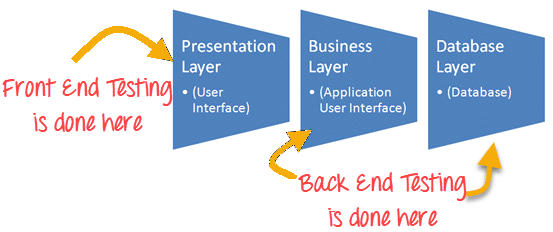What is Frontend Testing?
Frontend Testing is a Presentation layer test of 3-layer Architecture.
That is, you are checking the GUI – everything is displayed on the screen, on the client side. For a web application, front-end testing will include testing of functions such as forms, charts, menus, reports, etc. as well as related JavaScript. Frontend tests is a term that includes many different testing strategies. Testers need to have a good understanding and experience in business requirements to perform this type of test.

What is back-end testing?
Back-end Testing is a three-tier Architecture and Application test test.
In a complex software application such as ERP, Back-end Testing will require business logic testing in each application layer. For simpler applications, Backend testing checks either server or database. That means the data integrated into the user interface will be checked in the back database. Database formats can be SQL Server, MySQL, Oracle, DB2, etc. The data will be arranged in tables as records.
The database is checked for ACID properties, CRUD operations, their Schema, and compliance with business rules. The database is also tested for Security and Performance.
In Backend testing, there is no need to use GUI. You can directly transmit data in the browser with the parameters required for the function to receive feedback in some default formats. For example: XML or JSON. You also connect directly to a database and verify data using SQL queries.
Frontend Testing with Backend Testing
| Frontend Testing | Backend Testing |
|---|---|
| Frontend is always done on GUI | Back End Testing involves databases and business logic testing |
| Tester must have knowledge of business requirements as well as the use of automation framework tools | To be able to perform Back End Testing, the Tester must have a solid foundation of databases and structured Query Language (SQL) concepts. |
| GUI is used for testing | Can or may not use the GUI for testing |
| Do not need any information stored in the database | Need information stored in database |
| It is necessary to test the overall functionality of the application | Back End Testing is an important step to check for deadlock, data corruption, data loss, etc. |
| The types of tests that are done are unit tests, acceptance tests, accessibility tests, regression tests, and so on | Two types of widely used database tests are the SQL test, test API, and so on |
Important tools are used to perform Front-end testing
There are many tools available to be used for front-end testing. Here are three common front-end testing tools.
1. Grunt:
Grunt is one of the favorite tools when it comes to automating tasks. It is a JavaScript task launcher that provides bundled plugins for common tasks.
2. LiveReload:
LiveReload is a simple Web protocol. It triggers events for the client whenever the file is modified. Clients can handle this event in their own way, even when the most common case is when the file is modified.
3. Karma:
Karma is a test tool that runs JavaScript. It allows you to perform tests from workstation to production CI.
Important tools are used to perform Backend testing
Database testing also mentioned that Back-end testing is very important. Here are some Back-end testing tools to help find problems like deadlock, data corruption and poor performance.
1. Data Factory:
Data factory is a database testing tool. It works as a data generator and data manager to test the database. It has a very easy to use interface and is capable of managing complex data relationships.
2. Data Generator:
DTM Data Generator is another Back-end test tool. It is used to create data rows and schema objects to test the database. This tool supports the ability to use load and performance tests on a database.
3. TurboData
Turbodata software tool can be used to create test data with foreign keys. It allows the use of Select, Update and Delete SQL commands. It also supports multiple sequential files and relational databases.
Different
- Frontend testing tests the presentation layer of 3-Layer Architecture while Back-end testing is testing the application layer and database of 3-layer Architecture.
- Frontend testing is always done on the GUI while Back-end testing involves database and business logic testing.
- Frontend testing does not need any information stored in the database, but Back-end testing needs information stored in the database.
- Frontend testing is essential to test the overall functionality of the application while Back-end testing is important for checking deadlock, data corruption, data loss, etc.
- The frontend tester must have knowledge of business requirements and automation framework tools, while the Back-end tester must have a solid foundation of databases and structured Query Language concepts (SQL). ).
- Frontend testing examples are Unit Testing, Acceptance Testing, Accessibility Testing, Regression Testing, while auxiliary testing examples are SQL Testing, API Testing, etc.
The article was translated from source: https://www.guru99.com/
